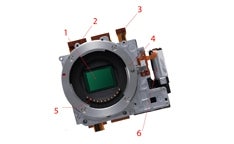The Guts: Panasonic Lumix DMC-GF1’s Shallow Lensmount
At only 0.76 inches thick, this lensmount is photography gear at its slimmest.

Shown larger than actual size, this lensmount (as part of the GF1) will run the gauntlet of our lab tests soon.
The distance from the front of lensmount in Panasonic’s Lumix DMCGF1 ($900, street; www.panasonic.com) to its sensor is, according to our estimates, about 0.76 inch. It’s quite slim. How? This live-view-only camera isn’t a DSLR, so there’s no mirror box up front to bulk it up.
1. Live Mos Sensor: This Micro Four Thirds sensor can read four channels of data simultaneously, helping the GF1 deliver 60 frames per second with its full-time live view. You can see it clearly in this photo because the GF1 isn’t an SLR, which requires a mirror box between the mount and the sensor.
2. Sensor Circuits: These flexible printed circuits (FPCs) transfer data from the sensor to the analog image processor.
3. Shutter Circuit: This flexible printed circuit handles communications between the shutter button and the shutter itself.
4. Lensmount: The diameter of this lensmount is about 0.24 inch smaller than a standard Four Thirds mount, but allows the same amount of light to hit the sensor. It’s manufactured from a block made of sintered stainless-steel powder, ground down to the mount shape. The process balances ease of manufacturing, good looks, and the strength needed to hold a lens. This is not a new material, though-it’s been used since the film days.
5. Signal Contacts: The Micro Four Thirds system has two extra signal contacts for smoother live-view shooting and faster communication between lens and body. They will also be used in the high-speed processing needed for continuous AF when shooting video.
6. Shutter Charge Motor: This motor charges the winder that cocks the shutter. To keep the GF1 compact but still incorporate a built-in flash, the engineers moved it closer to the camera’s front and designed it to be lighter and smaller.
More From The Guts
Nikon D3’s Viewfinder